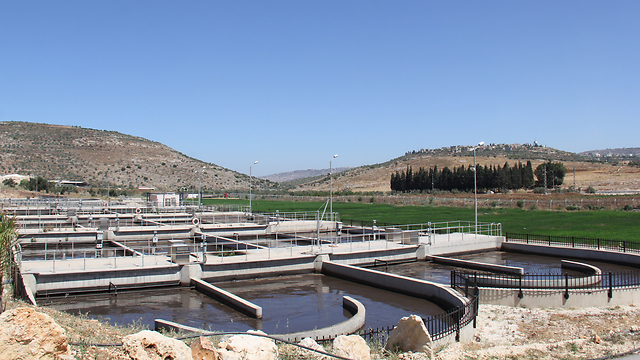
Israel to supply electricity to Gaza sewage treatment facility
The facility will treat 36,000 cubic meters of sewage a day, serving some 300,000 Gazans in the northern part of the strip; second agreement signed to supply electricity for Khan Yunis water desalination plant, serving some 500,000 Gazans in the southern part of the strip.
Israel's Water Authority signed an agreement with the Gaza Electricity Distribution Company last week to supply the strip with electricity to operate a sewage treatment facility.
In the first stage of the agreement, some three megawatts of electricity will be supplied to the facility in the northern Gaza Strip, while six additional megawatts will be supplied in the second stage.
Nine high capacity generators were brought into the strip for the facility. The project cost some $75 million and was funded by the World Bank and several donor countries.
The sewage treatment facility, which is expected to become fully operational within two months, will treat some 36,000 cubic meters of sewage a day, serving some 300,000 Gazans. It will also provide reused water for agriculture in the strip.
Israel will also supply 1.5 megawatts of power to the Khan Yunis desalination plant in southern Gaza, which was funded by the European Union to the tune of over $40 million.
At present, the plant provides 6,000 cubic meters of water a day to 500,000 Gazans, while in three months the water supply is expected to increase to 20,000 cubic meters a day.
"Israel has cross-interests in the Gaza Strip," said Alon Shoster, the head of the Sha'ar HaNegev Regional Council. "On the one hand, we want the immediate return of the soldiers' remains and the Israeli citizens being held in Gaza. At the same time, we want to encourage Hamas to normalize its ties and cooperate with the Palestinian Authority. That is an Israeli interest."
In addition, preventing a humanitarian crisis in Gaza "is a clear Israeli interest on the security, diplomatic and moral levels," he added.
"Maintaining this balance between Israel's interests and goals is entrusted to the government, which is exposed to all of the information and to the full complex reality," Shoster concluded.
The electricity crisis in Gaza began in April 2017, when the Palestinian Authority informed the Coordinator of Government Activities in the Territories (COGAT) that it intends to stop paying for electricity for Gaza. Palestinian President Mahmoud Abbas sought to pressure Hamas into giving him control of the strip, including its border crossings and the tax money Gazans pay Hamas for services it provides them with.
Hamas rejected Abbas's demands out of hand and warned of the catastrophic ramifications of such a move, but the Palestinian leader decided to nevertheless reduce the power supply to the strip.
In early January, Energy Minister Yuval Steinitz instructed the Israel Electric Corporation to renew regular power supply to Gaza due to "willingness by the Palestinian Authority to resume payments."
Gaza's electricity costs are estimated at some NIS 40 million, which Israel takes from tax money it collects on behalf of the Palestinian Authority.
Worsening humanitarian condition
The IDF's Southern Command is concerned by the worsening humanitarian situation in the Gaza Strip, fearing it could lead to another round of violence against Israel.
A decline in the purchasing power in Gaza led to a decrease in the number of trucks entering the strip with merchandise.
In the past, some 800-1,000 trucks passed through the Kerem Shalom border crossing into the Gaza Strip every day, but an all-time low was marked last week when only 325 trucks entered the strip on Monday.
In addition, many of the projects to rehabilitate the strip in the wake of the 2014 Operation Protective Edge have concluded, leading to a drop in jobs as well.
Even President Reuven Rivlin, who visited the Gaza border last week, expressed concern of the situation, saying "the time is nigh when the Gazan infrastructure will collapse and leave many residents in distress."













